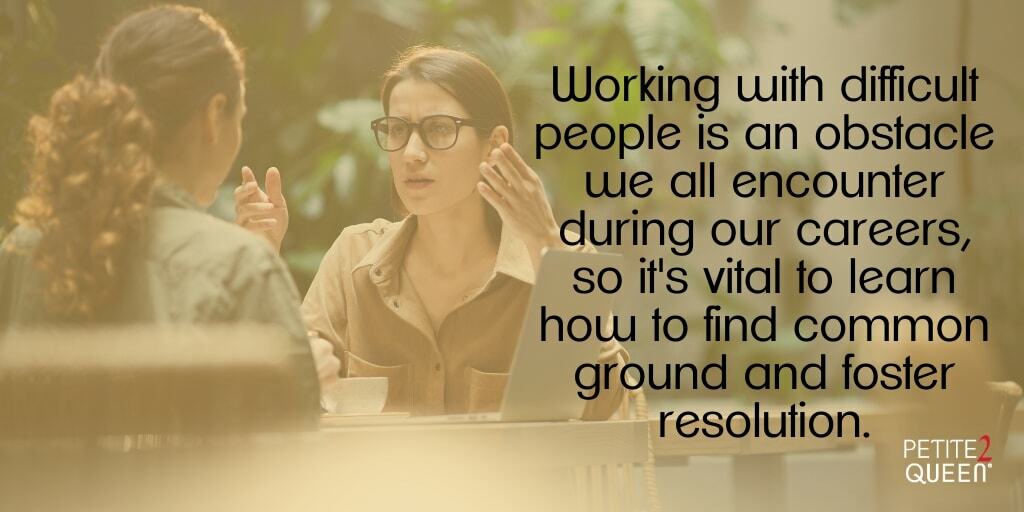There is someone I work with who is a bottleneck and I need to work with her daily. I’ve tried talking with her and have done everything I can think of to get what I need from her. I’m so frustrated. I’m dependent upon her so I can complete my work. What can I do to get her moving? – Korry in Knoxville, TN
Answer:
Working with difficult people is an obstacle we all encounter during our careers. It’s the type of thing that can bring us down and negatively impact our performance. Whether the other person is creating a bottleneck, ignoring your input, or rudely interjecting, the disruption is real and must be addressed.
Rather than allow yourself to fall into a pit of negativity, here are four proactive steps you can follow: Start with yourself, plan a conversation, set the tone, and implement a win-win solution. Let’s dive into how to find common ground and foster resolution.
Start with Yourself
Whenever there is conflict, it’s likely that we are consciously or unconsciously demonstrating our discontent. Our body language indicates a ton. In fact, research shows that body language accounts for 93% of communication. Recognizing how you are presenting and modifying your non-verbal appearance is the first step to eliminating challenges and bottlenecks.
Along with your body language, be aware of your tone of voice. Once again, this is an area that says more than the words you use. If your tone of voice is sickly sweet, patronizing, or aggressive, no matter how carefully prepared, your words will not resonate with the other person. They’ll be projecting your tone over anything you say.
And, when you do get a handle on your emotions, present positive body language, and maintain a cordial, professional tone, your words will matter. When you seek and see the good in the other person, the words you use will reflect this attitude. They are another human being. They have value and worthy intentions. Embrace that and you’ll be ready for the next step.

Plan a Conversation
Having completed your mindset work, you are ready to pick your spot for a conversation. It’s important to choose a neutral space for the discussion. Their cubicle or yours is never a good idea. Instead, move it out of home turf. Try somewhere like a conference room, offsite coffee lounge, or a video meeting. Virtual meetings can easily create a communal atmosphere, and are often the most practical setting.
Another aspect of picking your spot is scheduling the meeting. You want to avoid preemptive reactions, such as asking them in front of others. Email, text, or Slack is impersonal and easily misconstrued. Pick up the phone and ask them for a brief meeting. Let them select the day and time in the immediate future that is convenient. This gives them a win, however negligible, and it helps.
Before the meeting, identify your goal(s). Establish the key areas that need attention to achieve a positive outcome. Consider the other individual’s role, duties, and motivations. What can you envision that will directly or indirectly influence the situation? How can you mitigate or overcome those factors? Why is the outcome of value or importance to the other individual, your department, the initiative, or your organization?
Set the Tone
Now that you’ve prepared for the meeting, you are ready for a meaningful dialogue. Begin by asking questions. What are their thoughts about the influences and factors that are impacting the workflow? What are their suggestions for improvement? Use follow-up prompts such as “tell me more” and “help me understand” to expose the root of the issue.
Actively listen, process, and consider the other person’s input. The challenge or bottleneck will appear differently from their perspective. Acknowledging the viewpoint enables you to come together. By building a bridge, you can determine a path forward. You will find a mutually beneficial solution to resolve the obstacle or bottleneck.
Implement the Plan
Now that you have a plan, it’s time to implement it. Always do what you have said you will do, and act promptly on whatever commitments you have made. Follow up with the other person confirming you have put the solution in motion, and show your appreciation of their undertaking. As you work through the situation, continue to check in and see how the solution is working for them. Additionally, be open to pivoting or making refinements if the need develops.
What’s really cool about this four-step process is three-fold. One, you are developing a better, stronger relationship with your co-worker. Two, you are demonstrating your power skill of problem solving – to your peer and manager. And finally, you are embracing the mantle of positive leadership. Resolving conflict with grace and respect is a beautiful thing. Plus, you’ve filled your tool kit for the next time a challenge or bottleneck arises.

Lynn Whitbeck is the co-founder and President of Petite2Queen. She is focused on identifying and evaluating opportunities for women at work, helping them define their personal roadmap. She dedicates herself to delivering tools and insights, embracing visualization of the big picture, and identifying and implementing the minutiae of detail. Lynn aims to share lessons learned along her journey and enable positive uplift for women.

